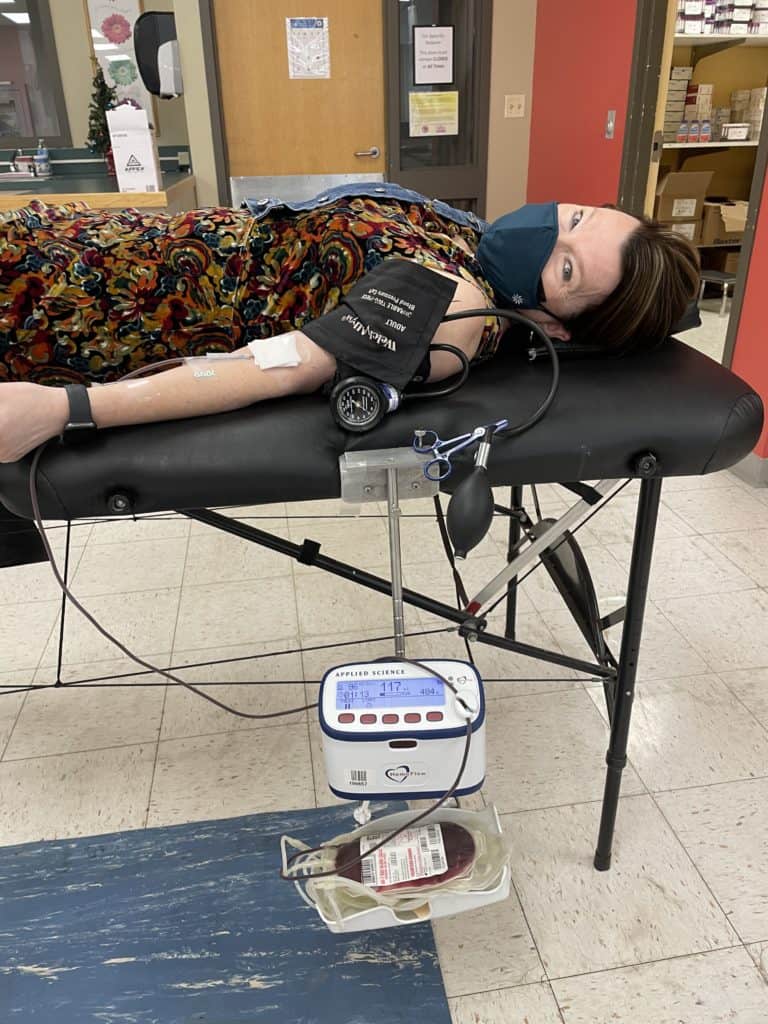A few important facts to consider:
Someone needs blood every two seconds.
Only 37 percent of the U.S. population is eligible to donate blood – less than 10 percent do annually.
About one in seven people entering a hospital need blood.
The average red blood cell transfusion is approximately 3 units.
A single car accident victim can require as many as 100 units of blood.
Blood and platelets cannot be manufactured; they can only come from volunteer donors.
The blood type most often requested by hospitals is type O.
One donation can potentially save up to three lives.
One in three people will need a donation in their lifetime
**If you think back to learning about blood types, you likely remember that O negative is the universal donor and AB positive is the universal recipient. If you don’t know your blood type, no worries-it will be typed for you upon your first donation!
Top reasons people don’t donate are:
- I don’t like or am scared of needles; I am afraid to give blood.
Many people feel that way at first. However, most donors will tell you that you feel only a slight initial pinch, and 7-10 minutes later, you are finished and headed for the canteen. If you take the time (and courage) to make one donation, you’ll wonder why you ever hesitated. - I am too busy.
The entire process takes about an hour, and the actual blood donation time is only 7-10 minutes. If you stop to think that an hour of your time could mean a lifetime for a premature baby, someone with cancer undergoing chemotherapy, or someone who’s had an accident, you might decide that you can make the time to give the gift of life. - No-one ever asked me … I didn’t realize my blood was needed.
Consider yourself asked! There is simply no other way to supply the blood needs of hospital patients but for the generous donations of people like you. Every two seconds someone in America needs blood. - I already gave this year.
You can give every 56 days. Many donors give 5 times a year! - I am afraid I’ll get AIDS.
It is not possible to get AIDS by donating blood to the American Red Cross. A new sterile needle is used for each donor and discarded afterwards. - My blood isn’t the right type.
Every type of blood is needed daily to meet patient needs. If you have a common blood type, there are many patients who need it, so it is in high demand. If you have a less common blood type, there are fewer donors available to give it, so it is in short supply. - I don’t have any blood to spare.
The average adult body has 10-12 pints of blood. Doctors say that healthy adults may give regularly because the body quickly replaces the blood you donate. - I don’t want to feel weak afterward.
Donating blood should not adversely affect a healthy adult because your body has plenty of blood. You will donate less than one pint, and your body, which constantly makes new blood, will replace the donated volume within 24 hours. Most people continue their usual activities after donating. - They won’t want my blood. (I am too old. / I’ve had an illness.)
If you have doubts, check with your physician. The qualified staff on duty at a blood drive will also review your medical history with you. There is no upper age limit to donate blood with the American Red Cross, and a great many medical conditions do not prevent you from donating blood, or may have done so only temporarily in the past. - I have a rare blood type, so I’ll wait until there is a special need.
Blood that is rare or special is almost always in short supply. There is a constant need for these blood types in order to avoid having to recruit specific blood types in a crisis.
source: American Red Cross
Although an altruistic endeavor, there are personal benefits that merit mention:
1. Giving blood stimulates the production of new red blood cells. Think of it as giving your own blood supply a little tune-up. It only takes about 24 hours for your body to replace the plasma from your donation. In four to six weeks, the red cells you donated will be completely replaced.
While you should avoid strenuous exercise for the rest of the day you donate, your body will operate at normal capacity while your blood cells are being replenished.
2. Donating blood can improve your cardiovascular health. Elevated levels of iron in the blood puts men at increased risk of heart disease. Donating blood takes iron out of your system (It’s gradually replenished by the foods you eat).
Men who donated blood at least once a year had an 88 percent lower risk of heart attacks than men who were not donors, according to a study published in the American Journal of Epidemiology.
3. Giving blood burns calories. Donors burn about 650 calories during a one-pint donation.
4. Getting a pre-donation screening gives donors a health update. As part of the donation process, you’ll have your pulse and blood pressure checked and your iron level tested. This is no replacement for an annual exam by your physician, but it could let you know of a change in your health.
5. Donating blood can boost happiness.
When you know you are saving a life, this triggers what is known as the “helper’s high.”
Source; Cape Cod Health
Finding out if I qualify:
The American Red Cross provides clear guidance on their website about situations in which blood donation is not permitted such as; not meeting age or weight requirements, acute illness such as cold or flu, low iron, low blood pressure, travel outside of the U.S. & some medications….to name a few. Even if you personally can’t donate you can certainly encourage others to, organize a blood drive at your work place or volunteer to help during a drive.







